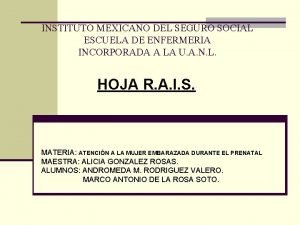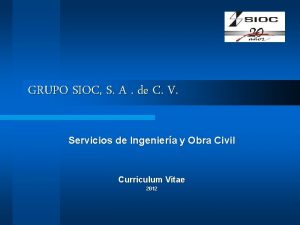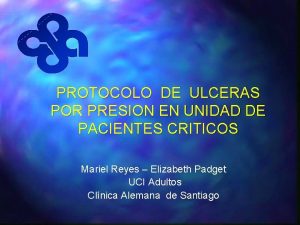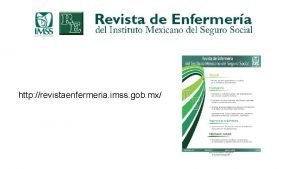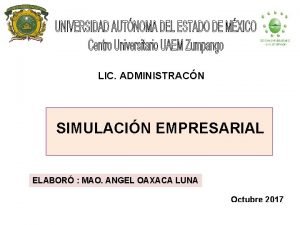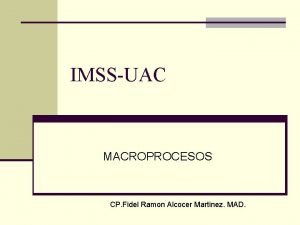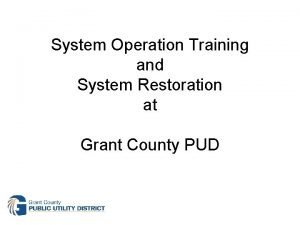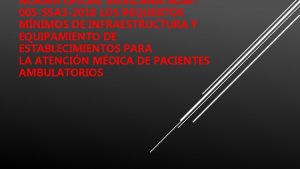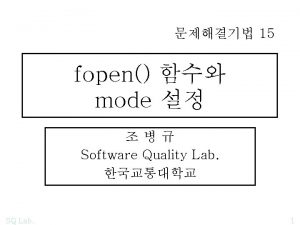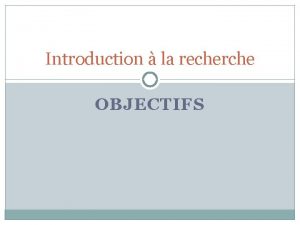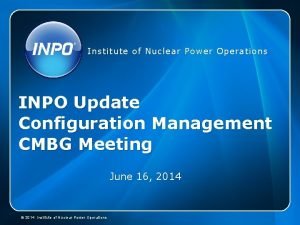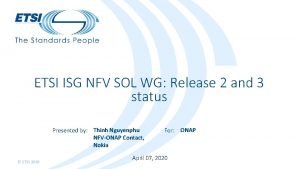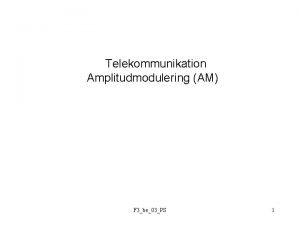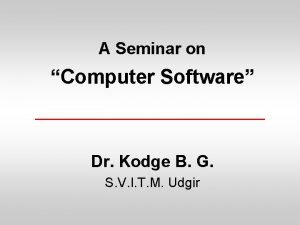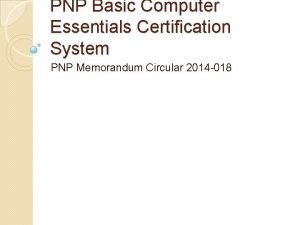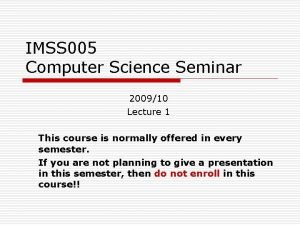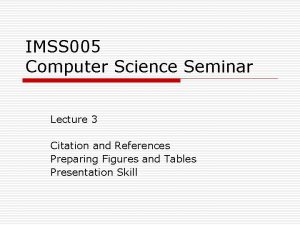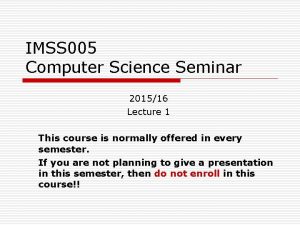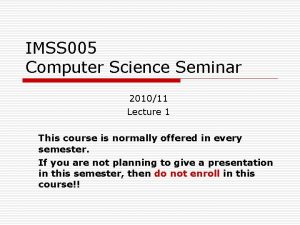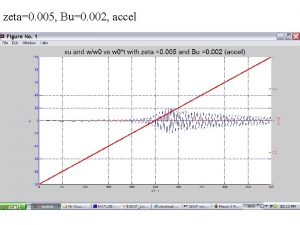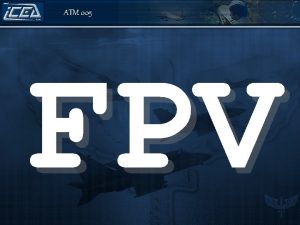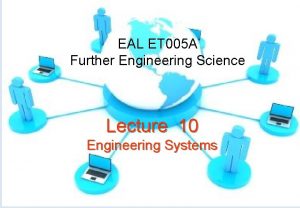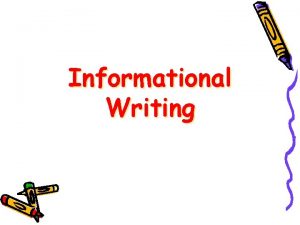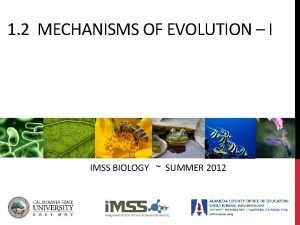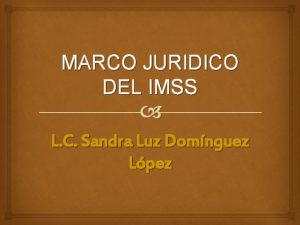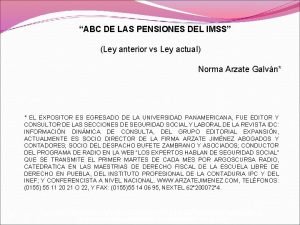IMSS 005 Computer Science Seminar Lecture 2 Writing




























- Slides: 28

IMSS 005 Computer Science Seminar Lecture 2 Writing a Literature Review Writing a Research Proposal

Writing a Literature Review

Literature Review o What is a literature review? n A summary of what has been published on a certain topic n e. g. , after studying a certain problem (say testing) n Write a simple summary about o An overview of different methods o The strength of the various methods o The weakness of the various methods

Why literature review is necessary? o A thick book and/or many papers vs several pages o To understand all recent/related work and use that knowledge to propose your own solution to the problem at a later stage.

Format of a literature review o If it is written as a separate report, n The literature review includes o o o o o Title page Acknowledgments (Optional) Abstract Table of contents List of figures List of tables Main text References Appendices (Optional)

Format of a literature review o Main text n Introduction o A brief description of the problem n Method discussion 1 o Technical details n Method discussion 2 o … n Conclusions

Writing a Research Proposal

Research Proposal o What is a research proposal? n A proposal of your new method o Methods/techniques o Applications n It includes the pros and cons (or comparisons) of other related methods

Format of a research proposal o A research proposal includes o o o o o Title page Acknowledgments (Optional) Abstract Table of contents List of figures List of tables Main text References Appendices (Optional)

Format of a research proposal o Main text n n n Introduction Problem Methodology/Approach Expected Outcomes Related work/ Literature Survey Work Schedule

Format o Abstract n Viewed as a summary of the document n Can be used by the readers to understand the content of the document quickly n It is also used to determine the relevancy.

Format o Abstract n Two types of abstracts 1. Informative (used to condense the paper) – used in conference/journal publications, research proposal 1. State the objectives and scope of the investigation 2. Describe the methods employed 3. Summarize the results or proposed outcomes 4. Summarize the conclusions 2. Indicative (indicates the subjects dealt with in a document) – used in literature review

Format o Abstract n It should not be longer than half of a page. n If you do not know how to write -> start with a draft Abstract in Chinese. n Avoid using long sentences and you will find it easier to translate them into English.

Format o Abstract n Read these sentences several times to see whether they are clearly expressed or not. Then translate them into English. n Make each sentence short and precise. n Again, read it several times. If possible, ask someone to read it and observe how much they understand. n Revise them if necessary. n Proof read your abstract several times for any errors and typos. n It is very ugly if you have mistakes in your abstract.

Format of a research proposal o Introduction n Remember, your reader may not be familiar with your area and it is your responsibility to guide him/her into your story. n Begin with introduction to terms and definitions related to your problem. n Start from easy ones and move on to more difficult concepts. n Consistent abbreviations and terms: o E. g. , Workflow Management Systems (Wf. MS). You should not use WFMS or Wf. Ms in later sections, . .

Format o Introduction n Once you have introduced the background knowledge about the domain, you can start talking about your motivations. n E. g. , you might want to give a brief review about recent work and o argue that their approaches lack certain functionalities and therefore should be improved in certain ways. o Should be brief and only address recent work which is directly related to your research. Detail should be postponed to Literature review.

Format of a research proposal o Problem n After you have stated your motivations in Introduction Section, you are now ready to describe what is your Thesis problem. n It must be very precise and you can itemize each sub-problem. e. g. n How to improve reporting functions in workflow n management systems based on audit trail data. Remember, these are the problems you are planning to solve and you should only write them if you are happy with it.

Format of a research proposal o Methodology/Approach n You should describe how to solve the problems that you have stated in the previous section. o Note: General description only. o Technical details literature review. n You can use different approaches for different problems. o E. g. , case studies for identifying hidden problems, o or using simulation for testing the performance, . . n itemize your approaches with respect to the problems defined in previous section.

Format of a research proposal o Expected outcomes n One of the most important sections in your proposal. n It is also an agreement between you and the faculty. n A lot of students write what they are going to do in this section. No, it is wrong!. n You should state what you are going to produce after 12 months. n if you have an itemized list, then each item in the list should start with a Noun. e. g, o An novel algorithm for improving the performance of string matching. o A detail analysis of reporting functions in Workflow Management Systems.

Format o Literature Review n The related methods / techniques / algorithms are discussed. o Sometimes, similar problems (to your thesis problem) with solutions are also discussed. n All of them are [usually] from papers / books. n Discuss them in details one by one

Format of a research proposal o Pros and Cons n Then, you should pinpoint what is missing or the weakness of the algorithm with respect to the scope of the research defined in your proposal. n E. g. if your proposal is about new algorithms for string matching in HTML data. n In that case, you can argue that the algorithm for string matching is only good for ASCII text and not suitable for HTML data.

Format of a research proposal o Work schedule n You have one year duration to complete your thesis. n See sample Timeline.

Work Plan

Work Plan

WORK PLAN o Part I: Data Modelling n Step 1: Build up an automotive engine performance model using Neural Networks based on the collected dataset. n Step 2: The output results from the model built will be verified on a chassis dynamometer. n Step 3: Fine-tune the performance model n Estimated period: 4 months

WORK PLAN o Part II Parameters Optimization n Step 1: Apply GA to the performance model built n Step 2: The output results of the optimal parameters will be verified though dynamometer tests. n Step 3: Fine-tune the GA parameters for better results n Estimated period: 4 months

WORK PLAN o Part III: n Preparation of conference & journal papers and thesis n Preparation for oral defense n Estimated period: 4 months o Total period: 12 months

Format of a research proposal o References n You have to prepare a list of references which are cited in your proposal. o Next lecture.
 01:640:244 lecture notes - lecture 15: plat, idah, farad
01:640:244 lecture notes - lecture 15: plat, idah, farad Hojas rais imss
Hojas rais imss Codigo de conducta de los servidores publicos del imss
Codigo de conducta de los servidores publicos del imss Digito verificador imss
Digito verificador imss Grupo sioc s.a. de c.v
Grupo sioc s.a. de c.v Llenado de cédulas autocorrección imss
Llenado de cédulas autocorrección imss Escala de norton imss
Escala de norton imss Revista de enfermeria imss
Revista de enfermeria imss 8 metas internacionales de seguridad del paciente
8 metas internacionales de seguridad del paciente Mao oaxaca
Mao oaxaca Titulo cuarto
Titulo cuarto Pepsu imss
Pepsu imss Imss siiau
Imss siiau Eop-005-2
Eop-005-2 Nrg gu005
Nrg gu005 Nom 005 ssa3 2018
Nom 005 ssa3 2018 Csc-005
Csc-005 Hoklas 005
Hoklas 005 Afnor z44-005
Afnor z44-005 Cmbg staffing
Cmbg staffing Sol 003
Sol 003 D.s. n° 005-2012-tr
D.s. n° 005-2012-tr 100000x0.05
100000x0.05 Science science science
Science science science Seminar about computer software
Seminar about computer software Computer training seminar memo
Computer training seminar memo Physical science lecture notes
Physical science lecture notes Computer security 161 cryptocurrency lecture
Computer security 161 cryptocurrency lecture Computer aided drug design lecture notes
Computer aided drug design lecture notes

